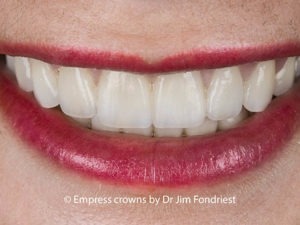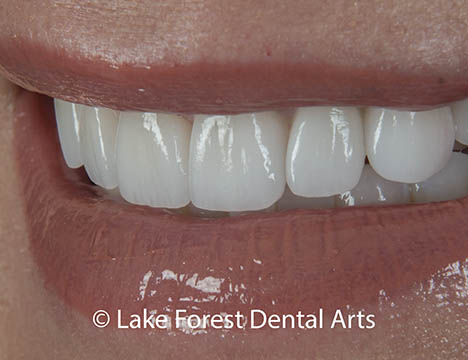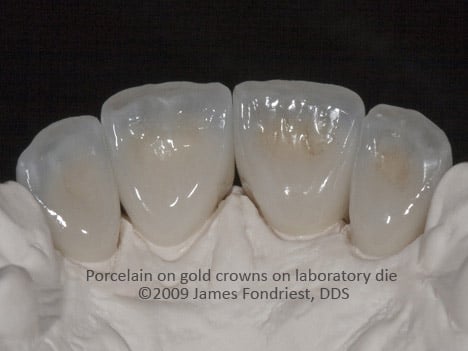
If you have some dental work, will your PFM crown look real? When we see patients with damaged and misshapen teeth or serious oral health issues, we can often correct the problem with treatments in restorative dentistry. There are many types of crowns but not all of them look natural. Because we know how important a beautiful smile is to our patients, Dr. James Fondriest offers lifelike, natural looking permanent crowns and veneers. The goal is to make your new restoration appear like a natural tooth.
What is a PFM Crown?
High quality pfm crowns can be very beautiful. In simple terms, it offers the strength of metal and the aesthetics of porcelain. While all ceramic crowns are certainly strong and resilient, they can still fracture and crack under extreme bite forces. Therefore, if you have a molar tooth that needs to be restored, this type or an all metal restoration are often the most reliable options.

This Winnetka patient unfortunately lost two of her front teeth in an accident. She brought several detailed photos of her smile as a teenager and wanted us to shape her new teeth just as they were 20 years before. The damage to her jaw precluded implants. PFM bridgework was created with the specific tooth shapes that she wanted.
Benefits of PFM Crowns
PFM crowns offer a wide range of advantages. For example, these restorations boast an impressive success rate. With proper hygiene care, the service life may be as much as 20-35 years. Furthermore, these restorations are preferred over other alternatives for patients suffering from bruxism. Additionally, they are also ideal when creating bridges, as they offer more strength compared to all-ceramic restorations.
Moreover, if they are made from high noble metal, they are extremely biocompatible, and rarely cause allergic reactions, irritation, or other complications.
Drawbacks of PFM Crowns
The ceramic used for these restorations is baked onto the substructure. It is very strong and can be abusive to the opposing teeth. Depending on the crown porcelain choices made by your dentist, we see varied amounts of wear on the natural teeth opposed to your restorations.
When it comes to crowns with a metal substructure, fractures are rare. However, if a PFM restoration sustains heavy bite forces, it is possible for some of the porcelain to chip off. This can usually be corrected with dental bonding, although more treatment may be necessary in some cases.
Because the porcelain is baked on top of a metal substructure, the quality can vary significantly depending on who creates them. Oftentimes, recession occurs around the crown and a black line will appear at the gum line. This is due to the metal portion that shows through the soft tissue. Dr. Fondriest can eliminate this problem with a special technique, which we will explore in more detail later on.
Unlike porcelain crowns, they do not trans-illuminate light on teeth roots. This can be an issue for those with thin gum tissue, as the illumination can make the gums appear brighter. On a tooth with a PFM crown, however, the gums may be visibly darker.
Lastly, when made with high noble metal alloys, they are typically more costly compared to base metal crowns. While all ceramic restorations usually carry a lower lab fee, they are not as long lasting. As a result, most patients find that they are well worth the higher price tag.

Tongue side view of PFMs on the laboratory die immediately prior to insertion. There is a 360 degree ceramic butt joint margin with absolutely no metal exposed.
PFM Crowns: Black Line at Gum Line
Earlier, we mentioned that some PFMs result in an unattractive black line where the restoration meets the gums. The whole point of choosing a porcelain fused to metal crown is to enjoy both strength and aesthetics. This is a common problem when dentists use non-precious or low noble alloys. Couple that with the fact that non precious alloys make ceramic less opaque, and you could end up with an exposed crown margin, which will likely be visible to others.
How Can We Address This Issue?
Dr. Fondriest uses only high noble gold alloys for the PFM substructure. Not only is this material far more biocompatible, it also creates a more natural look due to the warm colors of the high carat gold. Furthermore, Dr. Fondriest typically asks our lab to add a porcelain butt joint margin to each PFM crown. It is also great that Dr. Fondriest has relationships with several of the finest lab technicians in the U.S. This extra step requires the ceramist to add a layer of porcelain, extending it to the shoulder preparation. As a result, the black line is eliminated. Patients truly can have the best of both worlds: a resilient and long-lasting restoration that accurately mimics nature’s beauty.
Maintaining Your Dental Crown
These restorations are an investment in your appearance and overall oral health. Therefore, it’s important to care for your new restoration properly. While crowns do not require a lot of extra care, they do need to be cleaned thoroughly and regularly. To make sure your cap lasts for years to come, follow these recommended guidelines:
- Brush your teeth at least two times a day.
- Floss once daily with care
- Use an antibacterial mouthwash.
- Attend routine dental cleanings and exams.
Does Your Smile Need Natural Looking Crowns?
Many patients find they can maximize the beauty of their natural smiles with cosmetic treatments. We can create beautiful, custom-made restorations for our patients. To learn more, schedule a consultation at our Chicago, IL dental practice by calling 847-234-0517. We proudly serve residents of the Chicago metro area, as well as the Northwest and North Shore suburbs and all surrounding communities.
